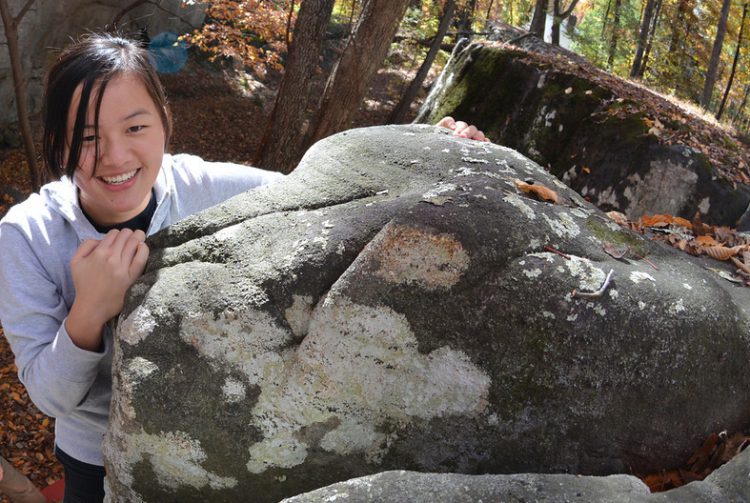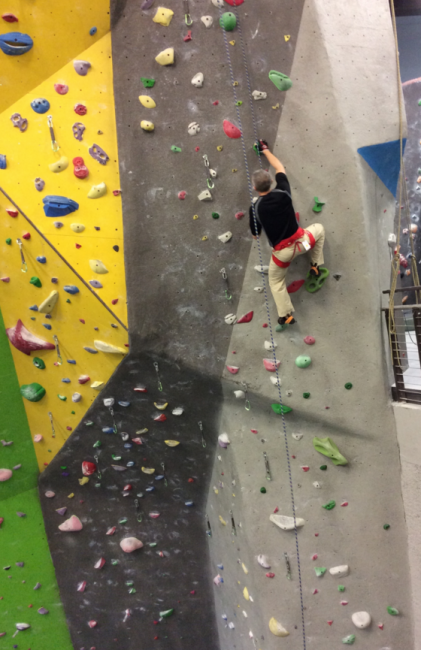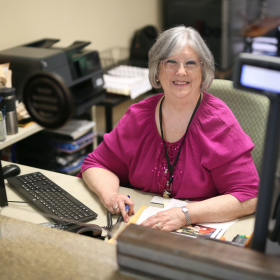Teenage daughter sparks interest in rock-climbing for Vanderbilt’s Dario and Nunzia Giuse
The passion for climbing has now affected all three members of the Giuse family
January 26, 2018
Erika Giuse’s interest in rock-climbing inspired her parents to take up the sport.
When Dario Giuse’s 14-year-old daughter Erika announced that she wanted to be a rock climber, he decided, even though he was 59 years old, to take up the sport with her.
He had been thinking about rock climbing for a while, and “at that point I said, well, time for me to make good on my promise to myself and make it happen,” he said.
It has happened in a big way — the passion for climbing has now affected all three members of the Giuse family, and Dario climbs almost every day, although usually at an indoor climbing wall.
“To me the attraction is first of all the exercise, second the fact that it’s a mental challenge as much as anything else, and third the fact that the people are so nice,” Dario said.
Dario Giuse grew up in the foothills of the Alps near the Italian-Swiss border, within a few hundred miles of some of Europe’s best rock climbing destinations. When he took up the sport, he’d been living for many years in Nashville.
Both Giuse and his wife joined Vanderbilt in 1994. Nunzia Giuse, MD, MLS, Vice President for Knowledge Management, was the last member of the family to start rock climbing, having taken it up some 18 months ago. Dario Giuse, PhD, MS, leads development of electronic health record systems at Vanderbilt.
Several years have passed, and now Erika, whose interest as a 14-year-old led to climbing as a family project, is now a sophomore at Carnegie Mellon University.

Dario Giuse hones his climbing skills daily, most often on indoor climbing walls.
The Giuses frequent climbing gyms. For natural rock climbing they’ve traveled to the West and Southwest United States, and, closer to home, they’ve climbed near Clarksville and near Chattanooga.
“To me the attraction is first of all the exercise, second the fact that it’s a mental challenge as much as anything else, and third the fact that the people are so nice,” Dario said.
“The whole climbing culture tends to be very open-minded. Nobody judges you if you’re a little overweight, if you’re a little too short, if you’re a newbie or anything like that, in fact everybody tries to be very helpful.”
Climbers should expect some aches and pains as they learn their physical limits, Giuse says, and minor scrapes are common, but more troubling injuries are entirely avoidable, “unless you’re doing something that’s really pretty crazy.” Climbing gyms allow a gradual acquisition of skills, and beginners can start practicing basic techniques with very little instruction.
“Where things become interesting is in lead climbing,” Giuse says. On a natural rock face the lead climber at intervals inserts spring-loaded camming devices into cracks or tight recesses in the rock, clipping the rope to each in succession (or clipping to permanently fixed climbing bolts where available). Stationed below, a climbing partner applies tension at the other end of the rope. In the event of a fall the harnessed climber is rescued by the topmost cam to which the rope has been clipped. Climbing rope is somewhat elasticated, so in a fall the sudden tautening of the rope is less jarring than it otherwise would be. To learn lead climbing, Giuse practiced falls of up to 25 feet.

Nunzia Giuse
The difficulty grading scale used for rock climbing routes in the U.S. ranges from 5.0 to 5.15, with routes rated 5.13 and higher reserved for elite climbers. Giuse has begun work on routes rated 5.13, “But this is indoor ‘top rope’ climbing, which is far from saying that I would be able to do that outdoors on lead,” he said.
The Giuses frequent Climb Nashville, a gym where Nunzia climbs about three days a week and where Dario climbs nearly every day.
“Outdoors it’s totally different, it’s am I going to find spiders as I climb up, is there going to be a wasp’s nest, is there going to be poison ivy — all the way to, is the rock wet, which makes it much, much more dangerous,” Giuse said.

Dario Giuse
Attempting more difficult routes is much more a matter of technique than of strength, he says.
“Having upper body strength is good, but you need to really use your legs — the stronger muscles in your body; you learn to think very carefully about what you do with your feet, and then your hands will take care of themselves.”
There are certain moves and techniques that rock climbers tend to find memorable and challenging, the most famous being the dyno, a jump taken by a lead climber when no hand holds are in reach. “Dynos tend to be pretty memorable because you miss it the first ten times, and then you finally get it and you say, how did I stick that?” Giuse said.
During a descent, climbers often have to feel for footholds without seeing them. That means, like many things in life, getting out of a situation is often much more difficult than getting into it; according to Giuse, the most difficult and strenuous part of rock climbing is climbing back down.










